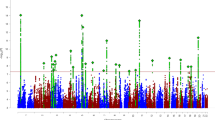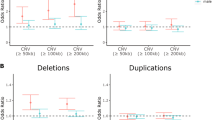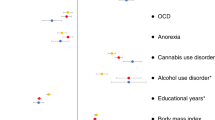Abstract
Although several studies have demonstrated an association between the 7-repeat (7R) allele in the 48-bp variable number of tandem repeats (VNTRs) in the exon 3 at dopamine receptor D4 (DRD4) gene and attention-deficit/hyperactivity disorder (ADHD), others failed to replicate this finding. In this study, a total of 786 individuals with ADHD were genotyped for DRD4 exon 3 VNTR. All 7R homozygous subjects were selected for VNTR re-sequencing. Subjects homozygous for the 4R allele were selected paired by age, ancestry and disorder subtypes in order to have a sample as homogeneous as possible with 7R/7R individuals. Using these criteria, 103 individuals (66 with ADHD and 37 control individuals) were further investigated. An excess of rare variants were observed in the 7R alleles of ADHD patient when compared with controls (P=0.031). This difference was not observed in 4R allele. Furthermore, nucleotide changes that predict synonymous and non-synonymous substitutions were more common in the 7R sample (P=0.008 for total substitutions and P=0.043 for non-synonymous substitutions). In silico prediction of structural/functional alterations caused by these variants have also been observed. Our findings suggest that not only repeat length but also DNA sequence should be assessed to better understand the role of DRD4 exon 3 VNTR in ADHD genetic susceptibility.
This is a preview of subscription content, access via your institution
Access options
Subscribe to this journal
Receive 12 print issues and online access
$259.00 per year
only $21.58 per issue
Buy this article
- Purchase on SpringerLink
- Instant access to full article PDF
Prices may be subject to local taxes which are calculated during checkout


Similar content being viewed by others
Accession codes
References
Polanczyk G, de Lima MS, Horta BL, Biederman J, Rohde LA . The worldwide prevalence of ADHD: a systematic review and metaregression analysis. Am J Psychiatry 2007; 164: 942–948.
Faraone SV, Perlis RH, Doyle AE, Smoller JW, Goralnick JJ, Holmgren MA et al. Molecular genetics of attention-deficit/hyperactivity disorder. Biol Psychiatry 2005; 57: 1313–1323.
Chang FM, Kidd JR, Livak KJ, Pakstis AJ, Kidd KK . The world-wide distribution of allele frequencies at the human dopamine D4 receptor locus. Hum Genet 1996; 98: 91–101.
Asghari V, Sanyal S, Buchwaldt S, Paterson A, Jovanovic V, Van Tol HH . Modulation of intracellular cyclic AMP levels by different human dopamine D4 receptor variants. J Neurochem 1995; 65: 1157–1165.
Missale C, Nash SR, Robinson SW, Jaber M, Caron MG . Dopamine receptors: from structure to function. Physiol Rev 1998; 78: 189–225.
Gizer IR, Ficks C, Waldman ID . Candidate gene studies of ADHD: a meta-analytic review. Hum Genet 2009; 126: 51–90.
Bakker SC, van der Meulen EM, Oteman N, Schelleman H, Pearson PL, Buitelaar JK et al. DAT1, DRD4, and DRD5 polymorphisms are not associated with ADHD in Dutch families. Am J Med Genet B Neuropsychiatr Genet 2005; 132B: 50–52.
Bhaduri N, Das M, Sinha S, Chattopadhyay A, Gangopadhyay PK, Chaudhuri K et al. Association of dopamine D4 receptor (DRD4) polymorphisms with attention deficit hyperactivity disorder in Indian population. Am J Med Genet B Neuropsychiatr Genet 2006; 141B: 61–66.
Carrasco X, Rothhammer P, Moraga M, Henriquez H, Aboitiz F, Rothhammer F . Presence of DRD4/7R and DAT1/10R allele in Chilean family members with attention deficit hyperactivity disorder. Rev Med Chil 2004; 132: 1047–1052.
Eisenberg J, Zohar A, Mei-Tal G, Steinberg A, Tartakovsky E, Gritsenko I et al. A haplotype relative risk study of the dopamine D4 receptor (DRD4) exon III repeat polymorphism and attention deficit hyperactivity disorder (ADHD). Am J Med Genet 2000; 96: 258–261.
El-Faddagh M, Laucht M, Maras A, Vohringer L, Schmidt MH . Association of dopamine D4 receptor (DRD4) gene with attention-deficit/hyperactivity disorder (ADHD) in a high-risk community sample: a longitudinal study from birth to 11 years of age. J Neural Transm 2004; 111: 883–889.
Hawi Z, McCarron M, Kirley A, Daly G, Fitzgerald M, Gill M . No association of the dopamine DRD4 receptor (DRD4) gene polymorphism with attention deficit hyperactivity disorder (ADHD) in the Irish population. Am J Med Genet 2000; 96: 268–272.
Holmes J, Payton A, Barrett JH, Hever T, Fitzpatrick H, Trumper AL et al. A family-based and case-control association study of the dopamine D4 receptor gene and dopamine transporter gene in attention deficit hyperactivity disorder. Mol Psychiatry 2000; 5: 523–530.
Leung PW, Lee CC, Hung SF, Ho TP, Tang CP, Kwong SL et al. Dopamine receptor D4 (DRD4) gene in Han Chinese children with attention-deficit/hyperactivity disorder (ADHD): increased prevalence of the 2-repeat allele. Am J Med Genet B Neuropsychiatr Genet 2005; 133B: 54–56.
Loo SK, Rich EC, Ishii J, McGough J, McCracken J, Nelson S et al. Cognitive functioning in affected sibling pairs with ADHD: familial clustering and dopamine genes. J Child Psychol Psychiatry 2008; 49: 950–957.
Qian Q, Wang Y, Zhou R, Yang L, Faraone SV . Family-based and case-control association studies of DRD4 and DAT1 polymorphisms in Chinese attention deficit hyperactivity disorder patients suggest long repeats contribute to genetic risk for the disorder. Am J Med Genet B Neuropsychiatr Genet 2004; 128B: 84–89.
Roman T, Schmitz M, Polanczyk G, Eizirik M, Rohde LA, Hutz MH . Attention-deficit hyperactivity disorder: a study of association with both the dopamine transporter gene and the dopamine D4 receptor gene. Am J Med Genet 2001; 105: 471–478.
Ding YC, Chi HC, Grady DL, Morishima A, Kidd JR, Kidd KK et al. Evidence of positive selection acting at the human dopamine receptor D4 gene locus. Proc Natl Acad Sci USA 2002; 99: 309–314.
Grady DL, Chi HC, Ding YC, Smith M, Wang E, Schuck S et al. High prevalence of rare dopamine receptor D4 alleles in children diagnosed with attention-deficit hyperactivity disorder. Mol Psychiatry 2003; 8: 536–545.
Grady DL, Harxhi A, Smith M, Flodman P, Spence MA, Swanson JM et al. Sequence variants of the DRD4 gene in autism: further evidence that rare DRD4 7R haplotypes are ADHD specific. Am J Med Genet B Neuropsychiatr Genet 2005; 136B: 33–35.
Hattori E, Nakajima M, Yamada K, Iwayama Y, Toyota T, Saitou N et al. Variable number of tandem repeat polymorphisms of DRD4: re-evaluation of selection hypothesis and analysis of association with schizophrenia. Eur J Hum Genet 2009; 17: 793–801.
Lichter JB, Barr CL, Kennedy JL, Van Tol HH, Kidd KK, Livak KJ . A hypervariable segment in the human dopamine receptor D4 (DRD4) gene. Hum Mol Genet 1993; 2: 767–773.
Iyengar SK, Elston RC . The genetic basis of complex traits: rare variants or ‘common gene, common disease’? Methods Mol Biol 2007; 376: 71–84.
Smith DJ, Lusis AJ . The allelic structure of common disease. Hum Mol Genet 2002; 11: 2455–2461.
Hirschhorn JN, Daly MJ . Genome-wide association studies for common diseases and complex traits. Nat Rev Genet 2005; 6: 95–108.
Wang E, Ding YC, Flodman P, Kidd JR, Kidd KK, Grady DL et al. The genetic architecture of selection at the human dopamine receptor D4 (DRD4) gene locus. Am J Hum Genet 2004; 74: 931–944.
Oldenhof J, Vickery R, Anafi M, Oak J, Ray A, Schoots O et al. SH3 binding domains in the dopamine D4 receptor. Biochemistry 1998; 37: 15726–15736.
Dalgarno DC, Botfield MC, Rickles RJ . SH3 domains and drug design: ligands, structure, and biological function. Biopolymers 1997; 43: 383–400.
Pawson T . Protein modules and signalling networks. Nature 1995; 373: 573–580.
Kay BK, Williamson MP, Sudol M . The importance of being proline: the interaction of proline-rich motifs in signaling proteins with their cognate domains. Faseb J 2000; 14: 231–241.
Grevet EH, Marques FZ, Salgado CA, Fischer AG, Kalil KL, Victor MM et al. Serotonin transporter gene polymorphism and the phenotypic heterogeneity of adult ADHD. J Neural Transm 2007; 114: 1631–1636.
Schmitz M, Denardin D, Laufer Silva T, Pianca T, Hutz MH, Faraone S et al. Smoking during pregnancy and attention-deficit/hyperactivity disorder, predominantly inattentive type: a case-control study. J Am Acad Child Adolesc Psychiatry 2006; 45: 1338–1345.
Santos NP, Ribeiro-Rodrigues EM, Ribeiro-Dos-Santos AK, Pereira R, Gusmao L, Amorim A et al. Assessing individual interethnic admixture and population substructure using a 48-insertion-deletion (INSEL) ancestry-informative marker (AIM) panel. Hum Mutat 2010; 31: 184–190.
Lahiri DK, Nurnberger JI Jr . A rapid non-enzymatic method for the preparation of HMW DNA from blood for RFLP studies. Nucleic Acids Res 1991; 19: 5444.
Stephens M, Scheet P . Accounting for decay of linkage disequilibrium in haplotype inference and missing-data imputation. Am J Hum Genet 2005; 76: 449–462.
Stephens M, Smith NJ, Donnelly P . A new statistical method for haplotype reconstruction from population data. Am J Hum Genet 2001; 68: 978–989.
Jones DT . Protein secondary structure prediction based on position-specific scoring matrices. J Mol Biol 1999; 292: 195–202.
McGuffin LJ, Bryson K, Jones DT . The PSIPRED protein structure prediction server. Bioinformatics 2000; 16: 404–405.
Kelley LA, Sternberg MJ . Protein structure prediction on the Web: a case study using the Phyre server. Nat Protoc 2009; 4: 363–371.
Obenauer JC, Cantley LC, Yaffe MB . Scansite 2.0: proteome-wide prediction of cell signaling interactions using short sequence motifs. Nucleic Acids Res 2003; 31: 3635–3641.
Ferraro E, Peluso D, Via A, Ausiello G, Helmer-Citterich M . SH3-Hunter: discovery of SH3 domain interaction sites in proteins. Nucleic Acids Res 2007; 35: W451–W454.
Puntervoll P, Linding R, Gemund C, Chabanis-Davidson S, Mattingsdal M, Cameron S et al. ELM server: a new resource for investigating short functional sites in modular eukaryotic proteins. Nucleic Acids Res 2003; 31: 3625–3630.
Sela M, White Jr FH, Anfinsen CB . Reductive cleavage of disulfide bridges in ribonuclease. Science 1957; 125: 691–692.
Dickson SP, Wang K, Krantz I, Hakonarson H, Goldstein DB . Rare variants create synthetic genome-wide associations. PLoS Biol 2010; 8: e1000294.
Goldstein DB . Common genetic variation and human traits. N Engl J Med 2009; 360: 1696–1698.
Larsen SA, Mogensen L, Dietz R, Baagoe HJ, Andersen M, Werge T et al. Identification and characterization of tandem repeats in exon III of dopamine receptor D4 (DRD4) genes from different mammalian species. DNA Cell Biol 2005; 24: 795–804.
Iakoucheva LM, Brown CJ, Lawson JD, Obradovic Z, Dunker AK . Intrinsic disorder in cell-signaling and cancer-associated proteins. J Mol Biol 2002; 323: 573–584.
Anwar T, Khan AU . Identification of a casein kinase II phosphorylation domain in NS1 protein of H5N1 influenza virus. Bioinformation 2007; 2: 57–61.
Volkenstein MV . Coding of polar and non-polar amino-acids. Nature 1965; 207: 294–295.
Xiong H, Buckwalter BL, Shieh HM, Hecht MH . Periodicity of polar and nonpolar amino acids is the major determinant of secondary structure in self-assembling oligomeric peptides. Proc Natl Acad Sci USA 1995; 92: 6349–6353.
Ren S, Uversky VN, Chen Z, Dunker AK, Obradovic Z . Short linear motifs recognized by SH2, SH3 and Ser/Thr kinase domains are conserved in disordered protein regions. BMC Genomics 2008; 9: S26.
Acknowledgements
We thank Conselho Nacional de Desenvolvimento Científico e Tecnológico (CNPq, Brazil), Institutos do Milênio (CNPq), PRONEX, and Fundação de Amparo a Pesquisa do Estado do Rio Grande do Sul e de São Paulo (FAPERGS e FAPESP) for financial support.
Author information
Authors and Affiliations
Corresponding author
Ethics declarations
Competing interests
Dr Rohde was on the speakers’ bureau and/or acted as consultant for Eli-Lilly, Janssen-Cilag and Novartis in the last 3 years. Currently, his only industry related activity is taking part in the advisory board/speakers bureau for Eli-Lilly, Novartis and Shire (<U$ 10 000 per year and reflecting <5% of his gross income per year). The ADHD and Juvenile Bipolar Disorder Outpatient Programs chaired by him received unrestricted educational and research support from the following pharmaceutical companies in the last 3 years: Abbott, Bristol-Myers Squibb, Eli-Lilly, Janssen-Cilag and Novartis.
Additional information
Supplementary Information accompanies the paper on the Molecular Psychiatry website
PowerPoint slides
Rights and permissions
About this article
Cite this article
Tovo-Rodrigues, L., Rohde, L., Roman, T. et al. Is there a role for rare variants in DRD4 gene in the susceptibility for ADHD? Searching for an effect of allelic heterogeneity. Mol Psychiatry 17, 520–526 (2012). https://doi.org/10.1038/mp.2011.12
Received:
Revised:
Accepted:
Published:
Issue date:
DOI: https://doi.org/10.1038/mp.2011.12
Keywords
This article is cited by
-
DRD4 48 bp multiallelic variants as age-population-specific biomarkers in attention-deficit/hyperactivity disorder
Translational Psychiatry (2020)
-
Attention-deficit hyperactivity disorder in adults: A systematic review and meta-analysis of genetic, pharmacogenetic and biochemical studies
Molecular Psychiatry (2016)
-
Evolution of the MHC-DQB exon 2 in marine and terrestrial mammals
Immunogenetics (2013)
-
Genetics of dopamine receptors and drug addiction
Human Genetics (2012)



